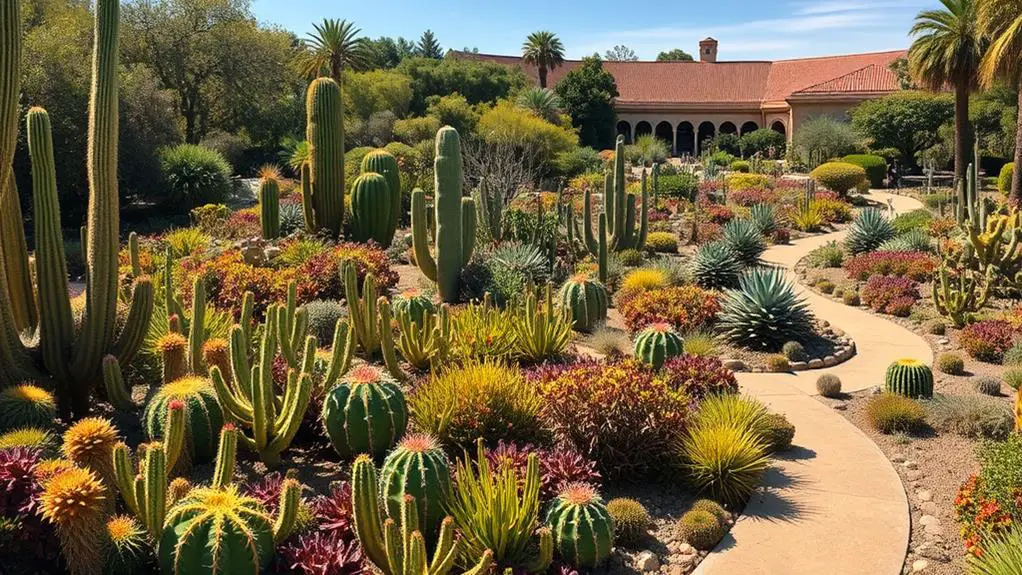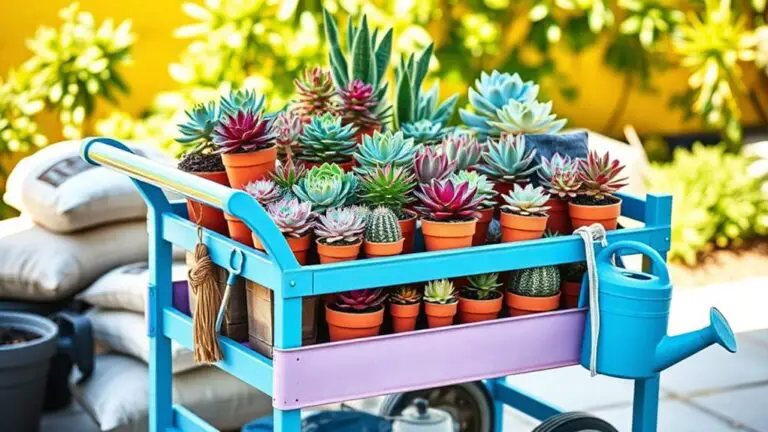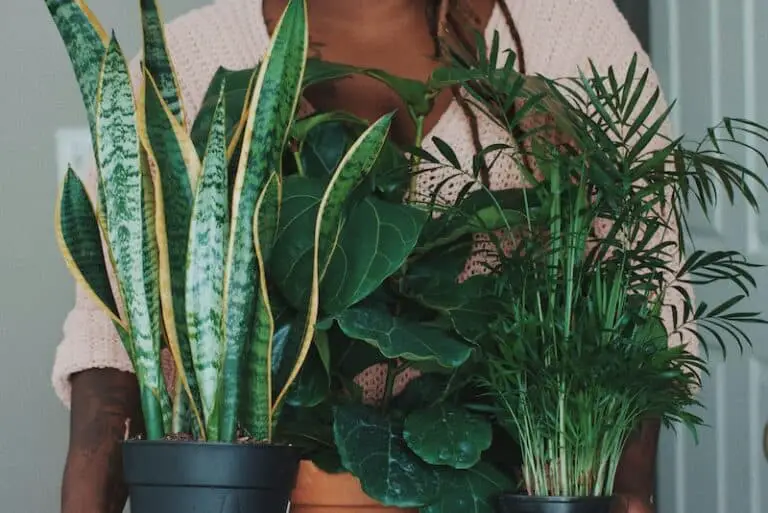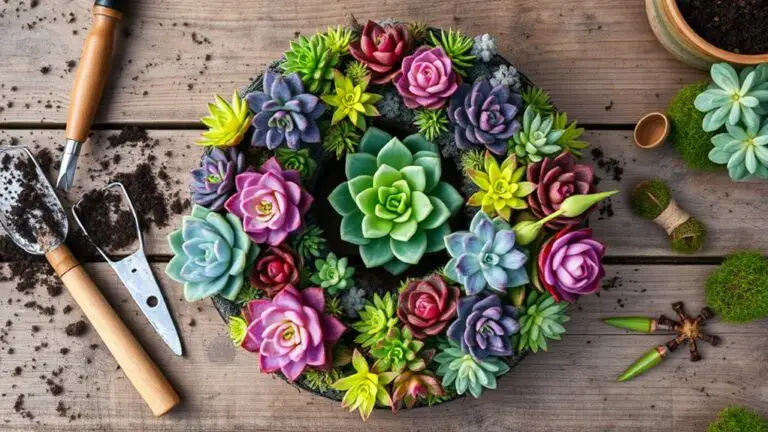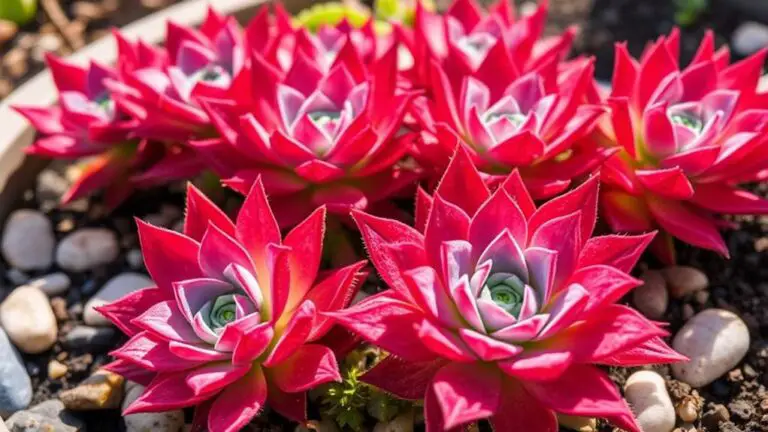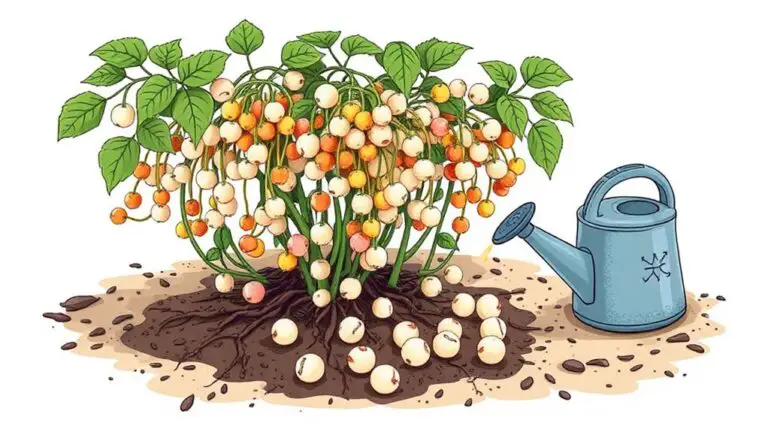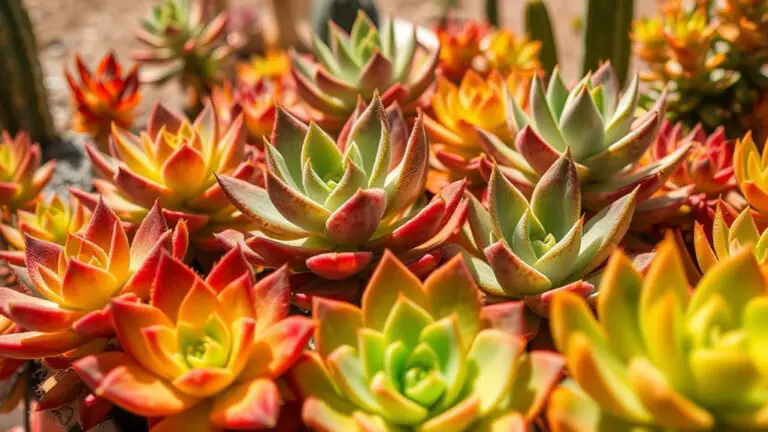Why Are the Succulents and Cacti Unique at the Huntington Library Gardens?
You might wonder what makes the succulents and cacti at the Huntington Library Gardens truly stand out. It's not just the sheer number of species—over 4,000—that they've meticulously curated from deserts around the world. These plants, some over a century old, offer a glimpse into the history of arid-region flora. The recent renovations have only enhanced the visitor experience, making it easier to appreciate these living survivors. But there's more beneath the surface of these resilient plants, aspects that reveal the garden's deeper commitment to conservation and education. Curious about what those might be?
Rich Historical Background
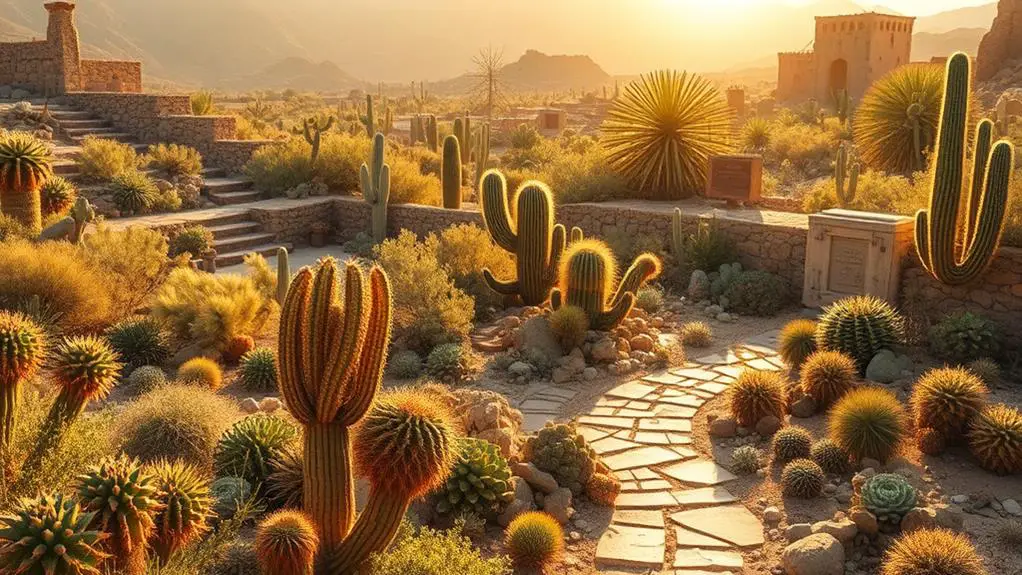
The rich historical background of the Huntington Desert Garden began in 1907 when William Hertrich planted about 300 cactus specimens on half an acre, setting the stage for what would become a world-renowned collection.
From these humble beginnings, the garden has grown to over 10 acres, showcasing more than 5,000 succulent plants from deserts all over the globe.
The historical significance of the Huntington Desert Garden can't be overstated. It's recognized as one of the top collections of succulent plants worldwide.
This status is rooted in over a century of careful cultivation and expansion. Collaborations with local nurseries and private collectors, combined with adventurous trips to the Southwest and Mexican deserts, have enriched the garden's diverse plant life.
The garden's journey is marked by important milestones, like the expansion of the cactus garden in 1925.
These efforts highlight the garden's commitment to preserving and educating the public about unique desert flora.
As you walk through the Huntington Desert Garden, you're not just seeing plants; you're experiencing a living history of horticultural excellence and exploration.
This rich past guarantees the garden remains an essential resource for learning and inspiration.
Extensive Garden Area
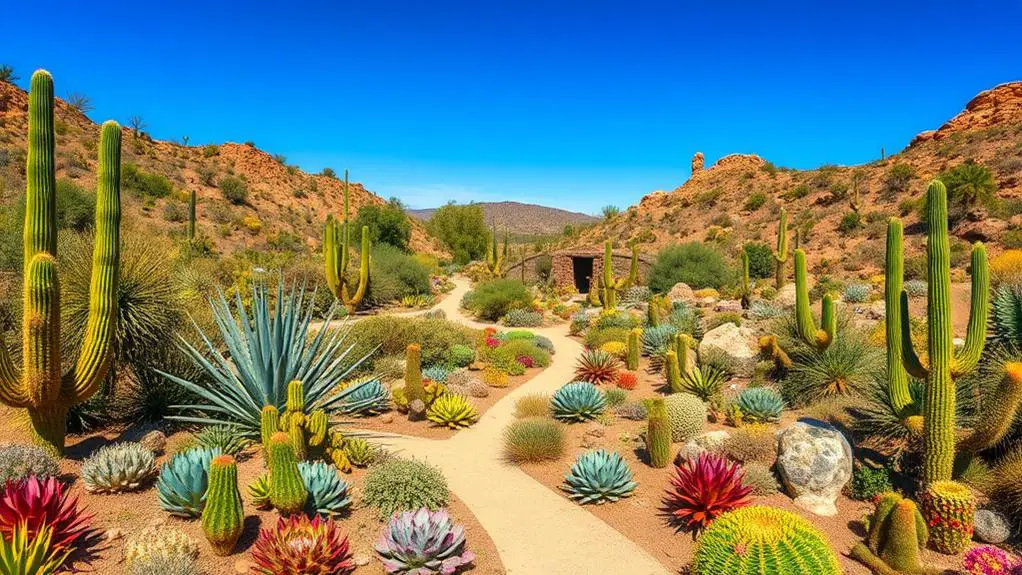
Spanning over 10 acres, Huntington Desert Garden stands as one of the largest collections of cacti and succulents globally. This extensive area hosts more than 4,000 types of arid-adapted plants, showcasing a diverse array of succulents and cacti from various regions. You'll find the garden organized into 60 landscaped beds, each designed to prioritize ideal growth conditions rather than strictly replicating a desert environment.
The garden's size allows for high-density planting, supported by an efficient irrigation system. This means the plants, including some mature specimens over 100 years old, thrive in their carefully managed environment. The recent renovations, which include new pathways and accessibility improvements, make it easier for you to explore and enjoy the expansive garden landscape.
Here's a quick overview to help you visualize the Huntington Desert Garden:
| Feature | Details |
|---|---|
| Total Area | Over 10 acres |
| Number of Plant Types | More than 4,000 |
| Landscaped Beds | 60 beds |
| Age of Some Specimens | Over 100 years old |
As you walk through the extensive area, you'll appreciate the thoughtful design and care taken to maintain this unique collection of cacti and succulents.
Conservation Initiatives
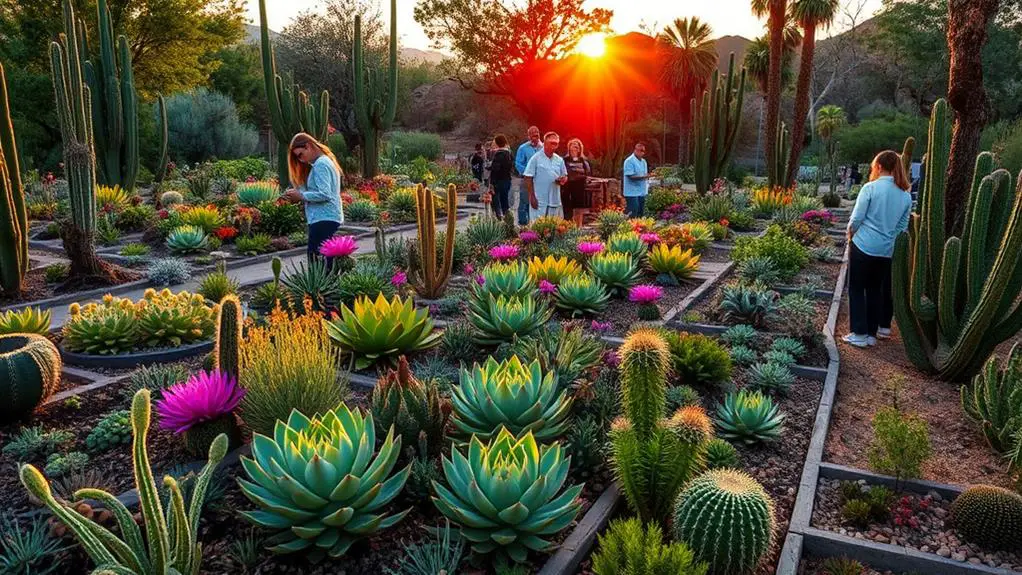
Taking on the mission of preserving biodiversity, Huntington Desert Garden prioritizes the conservation of diverse succulent species adapted to arid environments. You'll find many desert plants here that are endemic and vulnerable to extinction. This is due to habitat loss, climate change, and invasive species.
By focusing on these conservation initiatives, the garden plays a significant role in protecting these unique plants.
The Huntington isn't working alone. They collaborate with other institutions to tackle the challenges of plant conservation. Together, they engage in efforts to preserve threatened succulents and cacti.
For instance, the recent renovations, including the Desert Garden Conservatory, aim to improve growing conditions for about 2,000 sensitive plants. This further supports their conservation initiatives and helps guarantee that these desert plants thrive.
Moreover, the garden is dedicated to educating the public about desert ecosystems and the importance of conserving unique plant biodiversity.
Diverse Plant Families
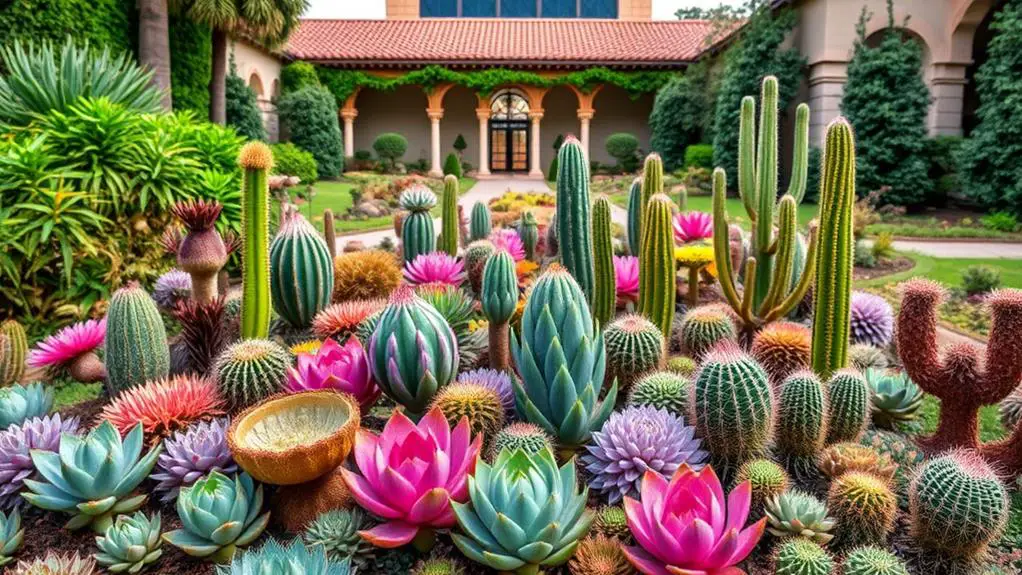
Conservation efforts at the Huntington Desert Garden extend beyond preserving individual plant species to celebrating an astounding diversity of plant families. You'll find over two dozen families of succulents here, each showcasing a unique adaptation to arid environments.
This garden, located in Southern California, includes more than 4,000 types of cacti and succulents, making it one of the largest collections worldwide.
The Huntington Desert Garden features both native and non-native species. You'll see plants from the Southwest and Mexican deserts, offering a glimpse into diverse desert flora.
Many of these plants are over 100 years old, giving you a historical perspective on how succulent cultivation has evolved over time. It's fascinating to imagine how these plants have thrived and adapted through the years.
The garden's high-density planting system is another highlight. It allows various species of succulents to grow successfully side by side.
Efficient irrigation techniques guarantee each plant gets the water it needs without waste. This method helps maintain the garden's variety and health, making it a model for sustainable gardening.
Unique Visitor Experience
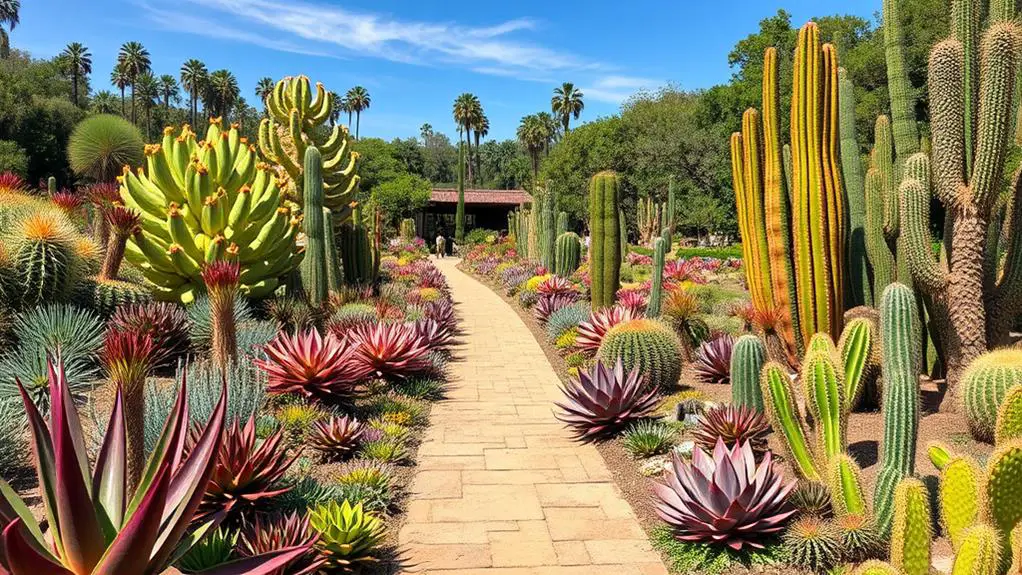
At The Huntington's Desert Garden, you can explore over 4,000 types of cacti and succulents, making it one of the largest collections in the world.
Take advantage of guided tours to learn about the unique features of these plants and the important conservation efforts being made.
You'll also enjoy newly renovated pathways and interactive activities like postcard-making, which let you reflect on your visit and share your experiences with others.
Guided Educational Tours
Frequently hailed as a must-see attraction, the guided educational tours at the Huntington Desert Garden offer an unparalleled experience for botany enthusiasts and casual visitors alike.
These tours provide you with in-depth knowledge about over 4,000 types of cacti and succulents, showcasing the garden's significance as one of the largest collections globally. You'll learn about the unique adaptations of desert plants and how they survive in harsh, arid environments. The guides will also discuss the challenges these species face due to climate change and habitat loss.
The tours highlight the garden's rich history, from the initial planting of approximately 300 cactus specimens in 1907 to its current 10-acre expanse. Knowledgeable guides share insights on the garden's ongoing conservation efforts, emphasizing collaboration with other institutions to preserve vulnerable succulent species.
Through these guided educational tours, you'll engage with the garden's commitment to conservation and learn practical ways to support these efforts.
Interactive elements of the tour encourage you to explore the unique features and aesthetic appeal of the garden's design. You'll even get to see mature specimens that are over 100 years old, making the experience both educational and visually stunning.
Diverse Plant Exhibits
As you conclude the enriching guided educational tours, the Desert Garden's diverse plant exhibits await to captivate your senses. Spanning over 10 acres, this garden features more than 4,000 types of cacti and succulents. It's one of the largest collections globally, offering a unique experience you won't find anywhere else.
You'll wander through 60 landscaped beds, each one thoughtfully designed to showcase a variety of arid-adapted plants. These beds are organized to mimic the plants' natural habitats, allowing you to see how different species thrive under ideal conditions.
This setup not only highlights the garden's biodiversity but also provides an extensive view of desert ecosystems. The Desert Garden includes both native and non-native succulents, representing flora from deserts around the world.
This diversity makes the garden a living library of desert plants, offering you a deeper appreciation for these resilient species. As you explore, you'll notice how the garden supports local wildlife, creating a vibrant and engaging environment.
Educational opportunities abound, with tours that focus on plant features and conservation efforts. These tours aim to foster a greater appreciation for desert ecosystems, making your visit both enjoyable and informative.
Interactive Garden Activities
Interactive garden activities at the Huntington Desert Garden offer visitors a unique and engaging way to connect with the natural world. You can immerse yourself in creating interactive postcards that depict the garden's beauty, allowing you to capture and share your personal reflections. These activities deepen your connection to the environment and foster creativity.
Guided tours are available to highlight the unique features of the succulent and cactus collections. You'll learn about the garden's conservation efforts, gaining a deeper understanding of these remarkable plants. The tours provide an educational experience that's both informative and enjoyable.
Seasonal events and activities focused on succulents and gardening encourage you to engage in hands-on learning. These experiences help you appreciate the importance of desert ecosystems and discover practical gardening tips.
The small amphitheater is perfect for classes and group activities, offering educational programs on desert flora and conservation. You can participate in group discussions and learn from experts.
With the completion of the Desert Garden Entrance Project, newly accessible pathways guarantee that everyone can explore the diverse garden layout comfortably.
| Activity | Description | Benefit |
|---|---|---|
| Postcard Creation | Design visual postcards of the garden | Enhances personal engagement |
| Guided Tours | Explore cactus and succulent collections | Educational and informative |
| Seasonal Events | Hands-on gardening activities | Appreciation for desert ecosystems |
| Amphitheater Classes | Group activities and educational programs | Focus on conservation |
| Accessible Pathways | Newly designed paths for better access | Inclusive visitor experience |
These interactive activities make your visit to the Huntington Desert Garden not only enjoyable but also enriching.
Recent Renovations
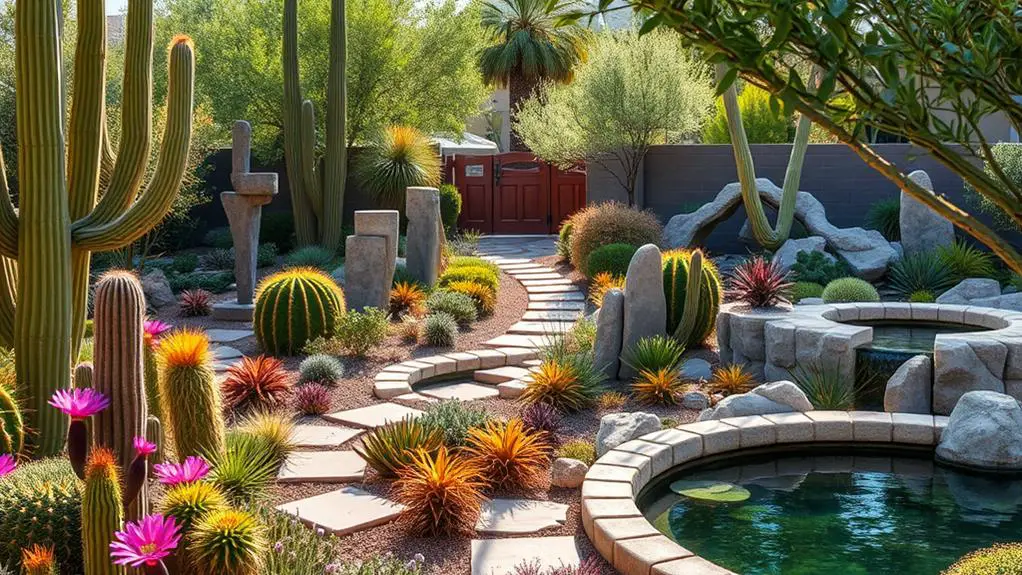
Recent renovations at the Huntington Library Gardens have greatly improved visitor accessibility and enhanced the overall garden experience.
The Desert Garden Entrance Project, completed in July 2023, introduced 1,300 feet of fully accessible pathways, making it easier for everyone to explore.
Additionally, new features like the renovated Desert Garden Conservatory and the upcoming wooden footbridge and amphitheater promise even more exciting adventures for you.
Improved Visitor Accessibility
The Desert Garden Entrance Project at the Huntington Library Gardens has greatly enhanced visitor accessibility, making the garden more welcoming for everyone. This project has created a formal entrance that markedly improves the visitor experience.
You'll find the new pathways more accessible, as they reduce steep slopes, making it easier for everyone to navigate the garden.
As of July 2023, the first phase of this project was completed. Now, you can enjoy 1,300 feet of fully accessible pathways throughout the Desert Garden. This means you can explore more of the unique succulent collection without struggling with difficult terrain. An additional half-acre of the upper Desert Garden is now accessible, offering you the chance to see even more of the garden's rare plants.
The improvements don't stop there. The third phase of renovations, ongoing through spring 2024, includes plans for a wooden footbridge and a gently graded walkway. These new features will connect different garden paths, further enhancing your visit.
Enhanced Garden Experience
Often, the best gardens evolve to meet the needs of their visitors, and the Huntington Library Gardens are no exception. With the recent completion of the Desert Garden Entrance Project in July 2023, you'll find that exploring the stunning succulents and cacti is easier than ever.
The project introduced a formal entrance and over 1,300 feet of fully accessible pathways, making the diverse plant layout more comfortable to navigate.
The first phase of renovations has also opened up an additional half-acre of the upper Desert Garden, enhancing your overall experience. These updates are designed to make sure you can enjoy every part of the garden without worrying about accessibility issues.
Looking ahead, future plans include a wooden footbridge and a gently graded walkway, which will connect the Desert Garden path to the Palm Garden path. This will make it even easier for you to explore different sections seamlessly.
Additionally, a small amphitheater is being designed for educational classes and group activities. This will support the garden's mission to inspire appreciation for desert ecosystems among visitors.
Artistic Garden Design
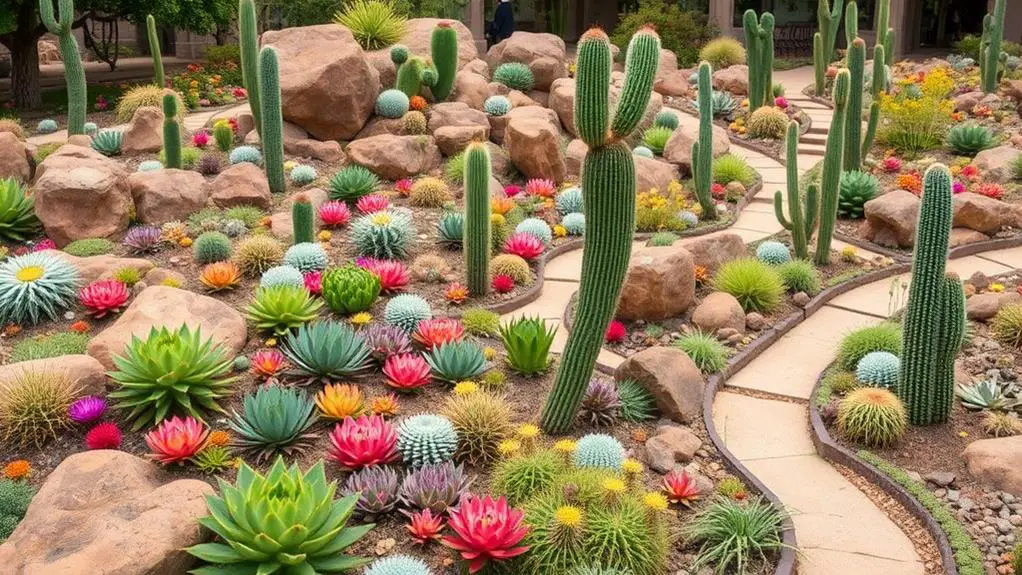
Imagine wandering through a garden where every plant is thoughtfully arranged to evoke awe and wonder. At the Huntington Library Gardens, the artistic design of the Desert Garden transforms natural forms into a stunning visual experience. The dramatic shapes of cacti create a living geometry, while the elegant arrangements of succulent spines add unique visual interest throughout the landscape.
You'll notice how vibrant flowers from Aloes and Echinocactus enhance the garden's beauty, drawing in photographers and nature enthusiasts. These blooms aren't just pretty; they add to the dynamic visual interest, making every visit unique. Seasonal blooms from plants like mesembs and kalanchoe surprise you with bursts of color, ensuring the garden is always changing and engaging.
The thoughtful placement of towering cacti encourages visitors to pause and reflect, allowing you to engage deeply with the artistic elements. This mindful approach to design means you can enjoy both the stunning visuals and the serene atmosphere.
The Huntington's botanical collections are arranged with such care that every step you take feels like a journey through an ever-changing masterpiece. Whether you're a gardener or simply a nature lover, you'll find inspiration around every corner.
Educational Programs
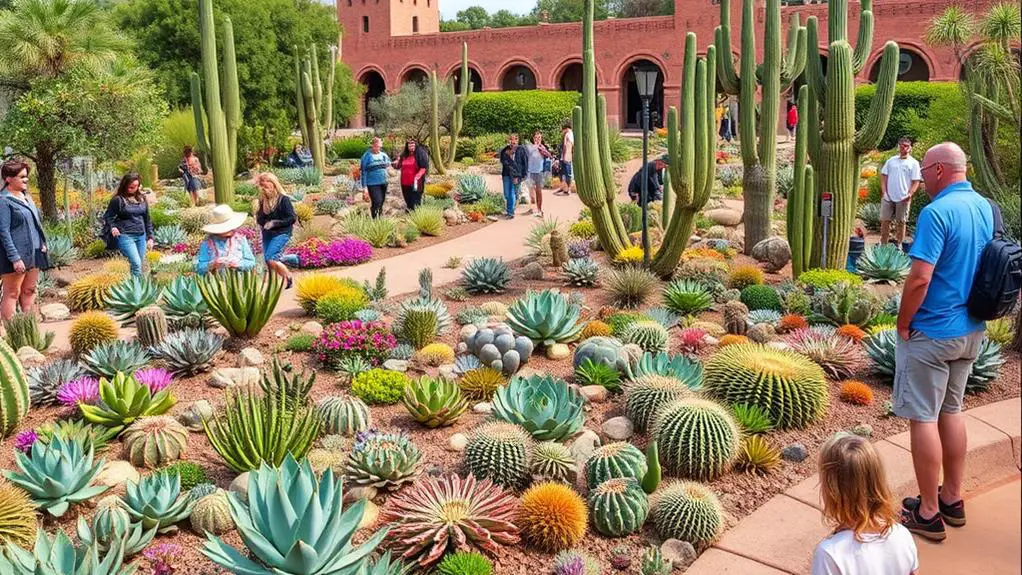
Nestled within the Huntington Library Gardens, the Desert Garden's educational programs offer a unique opportunity to explore the fascinating world of cacti and succulents. These programs focus on the unique adaptations and conservation of over 4,000 types of these plants, helping you understand the importance of desert ecosystems.
When you join a guided tour, you'll gain insights into the incredible diversity of arid-adapted plants. You'll also learn why preserving these species is vital, especially as environmental challenges grow. The tours are perfect for anyone curious about how these plants survive and thrive in harsh conditions.
But that's not all! The Desert Garden hosts interactive activities like creative postcard projects. These activities let you express your reflections on the desert flora while deepening your appreciation for their significance. It's a fun and engaging way to connect with the plants and understand their role in the ecosystem.
Additionally, the garden offers classes and workshops focused on succulent care and sustainable gardening practices. These initiatives will equip you with the skills needed to nurture your own plants.
And with the new amphitheater, you'll find even more opportunities to engage with community events centered around plant conservation and environmental awareness.
Frequently Asked Questions
What Is the Big Deal About Succulents?
Succulents are a big deal because they store water in their stems and leaves, thrive in arid environments, and showcase unique adaptations. Their dramatic shapes and vibrant flowers make them visually stunning and ecologically important.
What Is the Meaning of Succulents and Cacti?
Succulents store water in their stems, leaves, or roots, letting them survive in arid environments. Cacti are a family of succulents with unique features like areoles, which produce spines and flowers, mostly found in North America.
What Is the History of the Cactus Garden?
You'll find the cactus garden's history fascinating. It started in 1907 with 300 plants under William Hertrich. Despite initial skepticism, it expanded to over 10 acres and 5,000 plants, becoming a key site for conservation and education.
Why Did Succulents Become Popular?
You've likely noticed succulents' popularity due to their low-maintenance, drought-resistant nature, and aesthetic versatility. They thrive indoors, need minimal care, and social media has made them trendy among young gardeners. Plus, they're eco-friendly!
Conclusion
So, when you visit the Huntington Library Gardens, you'll see more than just plants. You'll immerse yourself in a rich history and explore a garden that's been carefully crafted for over a century. The diverse succulents and cacti, along with the garden's commitment to conservation and education, make it a unique experience. Use what you learn to inspire your own garden. With patience and care, you can grow your own resilient plants at home, just like at the Huntington.

